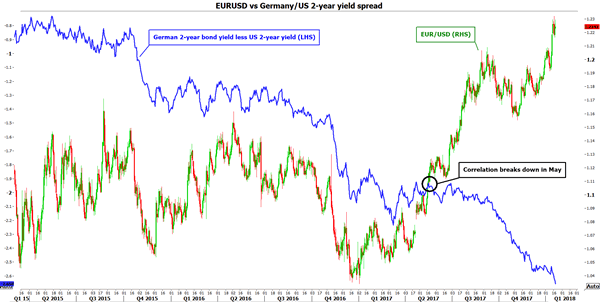The euro started the year with a bang, buoyed by expectations that the European Central Bank (ECB) is likely to begin scaling back its massive stimulus program later this year. Can the single currency continue to gain, or have markets discounted too much too early, setting the stage for a near-term correction?
While the financial community widely anticipates the euro to continue its winning streak in 2018, few expected the currency to gain so rapidly in the first few days of the year. Interestingly enough though, while euro/dollar currently rests near 3-year highs, spreads between the yields of German and US bonds are actually declining, which suggests that the pair’s gains are not being driven by movements in the bond market or relative interest rates.

The euro began moving higher after the minutes of the ECB’s December policy meeting showed the Bank could begin adjusting its forward guidance in early 2018, lending further credibility to expectations that it will unwind its massive QE program this year. What caught investors by surprise was the potential timing of such a move. Considering that QE is intended to run at least until September, one would have expected the Bank to begin calibrating its language around QE around the middle of 2018, not early in the year.
Unsurprisingly, the gains the euro posted following the minutes made the ECB nervous. So much so, that several key policymakers – including Vice President Constancio – soon "jawboned" the currency, causing it to correct lower by indicating that sudden FX moves that do not reflect fundamentals are a source of concern. Of course, this is a typical reaction by the ECB. The Bank is unlikely to sit idle and allow the euro to appreciate rapidly, as that could make it more difficult for inflation to reach its target in a sustainable manner.
This could also be a taste of what is to come. The ECB is due to hold its policy meeting next week and although no change in either policy or guidance is expected, President Draghi could take the opportunity to echo his colleagues’ concerns regarding the exchange rate. Even if he does not mention the euro specifically, the ECB chief will probably want to maintain a cautious tone and downplay hawkish expectations – perhaps by focusing on the still-subdued core inflationary pressures – as anything other than that could trigger another wave of appreciation in the euro. In such a scenario, euro/dollar could drift lower, and potentially test the 1.2080 territory as a support. Politics are another factor arguing for a near-term downward correction in the euro, with Italy’s upcoming election in March and the political uncertainty in Germany posing downside risks for the single currency over the next weeks.
On a longer-term horizon, however, the outlook for the euro remains largely positive. Even if the currency corrects lower in the coming weeks on ECB jawboning or politics, any dips could remain short-lived, amid heightened expectations for a QE-tapering announcement later this year and a strengthening Eurozone economy. A realistic timeline of how events may unfold is one where the Bank adjusts its forward guidance at either the March or April policy meetings, thereby paving the way for a June/July announcement that QE purchases will begin to be scaled back by September. Thus, barring some major surprise, such as a sharp slowdown in Eurozone’s inflation or Germany heading to elections again, euro/dollar could challenge 1.2570 resistance zone even before the end of the year.














